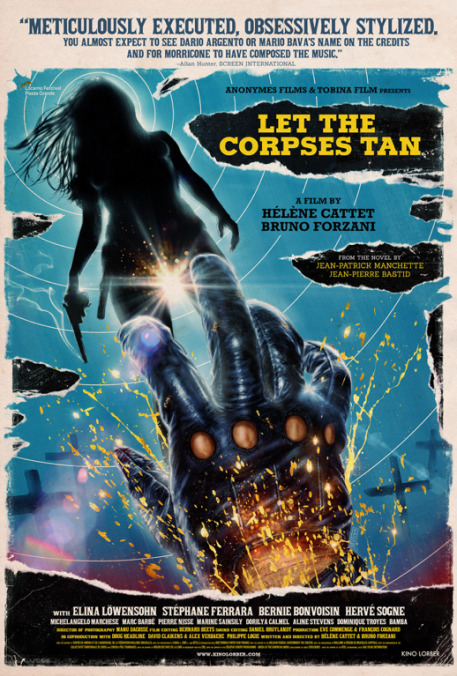The films of Hélène Cattet and Bruno Forzani are, above all else, sensory experiences. The sense memories evoked by their new film, Let The Corpses Tan (Laissez Bronzer Les Cadavres), include: Blinding sunlight. Bare feet on sharp rocks. Sweat pooling on your upper lip. The film of salt that forms on your skin after bathing in the sea. The biting touch of scorching hot metal. The cries of vultures slowly circling overhead.
The film takes place entirely on an anonymous, sunbaked Mediterranean island, where a gang of thieves led by the Bronson-esque Rhino (Stéphane Ferrara) is laying low at a modest clay-brick home owned by the tough, witchy Madame Luce (Elina Löwensohn) after pulling off a massive gold heist. There, they encounter Bernier (Marc Barbé), a writer who spends most of his time napping in the nearby ruins, as well as—quite unexpectedly—Bernier’s wife (Dorylia Calmel), son (Bamba Forzani Ndiaye), and nanny (Marine Sainsily), who hitch a ride to Madame Luce’s cliffside hideout with Rhino and his gang.
Compared to the practically plotless Strange Color, Let The Corpses Tan is relatively narrative-driven, which makes sense given that it’s Cattet and Forzani’s first time working with a screenplay adapted from another source. (The original novel of Laissez Bronzer Les Cadavres, by Jean-Pierre Bastid and Jean-Patrick Manchette, launched a new movement in French crime fiction upon its release in 1971.) The majority of the film unfolds over the course of only a few hours, recounting in fragmented Rashomon style the shootout that occurs when a pair of motorcycle cops (Hervé Sogne and Dominique Troyes) stumble upon this already volatile criminal crew.
Combined with the directors’ predilection for abstract montage, the multiple perspectives make said plot quite difficult to follow, despite the presence of intertitles marking the passage of time. But if you let go of the need to keep names and relationships straight, and just accept that there are cops, robbers, and innocent bystanders all shooting at each other, the film is equally enjoyable as a free-flowing series of sounds and images. Visually, Cattet and Forzani nod to Sergio Leone and Giulio Petroni with the frequent use of extreme close-up on the characters’ faces, as well as the garish splashes of red, blue, and green in the opening credits. The sound is also skillfully executed, both in the thoughtful application of sound effects—leather fetishists will be pleased to note its creaking is still at the front of the mix—and in the time-capsule soundtrack, featuring musical cues from Ennio Morricone (naturally) and Nico Fidenco.
In many spiritual traditions, repetition—whether through chanting, drumming, dancing, or some other form of ritual practice—is used to lift acolytes out of their everyday reality and into a heightened one. Either you give in and get caught up in the moment, or you get bored and frustrated. The same holds true for Let The Corpses Tan. At regular intervals throughout the film, Cattet and Forzani cut away from the action to an abstract plane, where a nude woman is covered in gold, tied to a cross, and whipped as devotees lick the foaming sweat from her torso. Later, she stands over an anthill and pees on the insects crawling below; the anthill is an exact replica of the compound where the main action is taking place, which must make this woman some sort of god. This is a worshipful film, adoring of guns, of gold, of the human body, and of cinema itself. Supplicate yourself before it.

